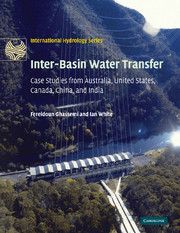Book contents
- Frontmatter
- Contents
- Foreword
- Overview and Scope
- Acknowledgements
- List of Abbreviations
- Part I The Challenges
- Part II Inter-basin Water Transfer in Australia
- 3 Land and water resources of Australia
- 4 The Snowy Mountains hydro-electric scheme
- 5 Inter-basin water transfer from coastal basins of New South Wales
- 6 The Bradfield and Reid schemes in Queensland
- 7 Three schemes for flooding Lake Eyre
- 8 The Goldfields pipeline scheme of Western Australia
- 9 Supplying Perth, Western Australia with water: the Kimberley pipeline scheme
- 10 Other schemes in Australia
- Part III Inter-basin Water Transfer in Other Selected Countries
- Part IV Appendices
- Glossary
- Index
- References
8 - The Goldfields pipeline scheme of Western Australia
Published online by Cambridge University Press: 05 November 2009
- Frontmatter
- Contents
- Foreword
- Overview and Scope
- Acknowledgements
- List of Abbreviations
- Part I The Challenges
- Part II Inter-basin Water Transfer in Australia
- 3 Land and water resources of Australia
- 4 The Snowy Mountains hydro-electric scheme
- 5 Inter-basin water transfer from coastal basins of New South Wales
- 6 The Bradfield and Reid schemes in Queensland
- 7 Three schemes for flooding Lake Eyre
- 8 The Goldfields pipeline scheme of Western Australia
- 9 Supplying Perth, Western Australia with water: the Kimberley pipeline scheme
- 10 Other schemes in Australia
- Part III Inter-basin Water Transfer in Other Selected Countries
- Part IV Appendices
- Glossary
- Index
- References
Summary
INTRODUCTION
In 1826, the British set up a military settlement at King George Sound near Albany, in the south-west corner of Western Australia. Three years later, the first settlers arrived at the Swan River, and established the first huts and buildings at the site of Perth and at the nearby port of Fremantle. In February 1832, Western Australia officially became a Crown Colony and Captain James Stirling was appointed as the Governor. The population of the Colony gradually increased and by 1850 had reached about 6000. Western Australia was finally granted self-government in 1890 (Shaw, 1984, pp. 688 and 689).
In 1885, a small quantity of gold (10 ounces) was discovered at Kimberley in the far north of the Colony. By April 1886 this amount had grown to 400 ounces. The Kimberley Goldfields had limited reserves and did not last long (Ewers, 1935, p. 30). In late 1887, gold was also discovered at Yilgarn, north-east of Perth (Figure 8.1). This was followed by the discovery of gold at other locations around the Colony. At Coolgardie, Arthur Bailey and William Ford discovered gold in September 1892, and returned with 554 ounces (15.7 kg) of gold worth around £2000 (Evans, 2001, p. 138), or about $324 000 at 2002 gold prices. In Kalgoorlie, Patrick Hannan, with two other Irish prospectors, discovered gold on 10 June 1893 (Blainey, 1993, p. 2).
The discovery of gold attracted thousands of people to Western Australia from the eastern Australian states and also from other countries.
- Type
- Chapter
- Information
- Inter-Basin Water TransferCase Studies from Australia, United States, Canada, China and India, pp. 151 - 164Publisher: Cambridge University PressPrint publication year: 2007

